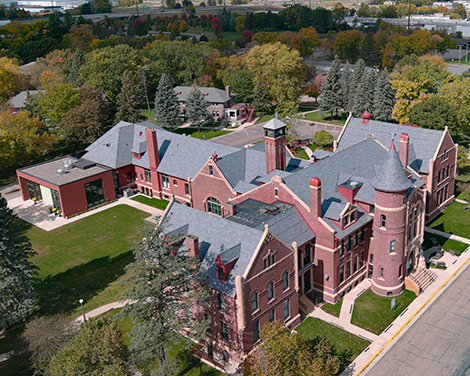Published in Roofing Magazine on November 24, 2020 by Chris King.
The massive brick complex in Owatonna, Minnesota, that currently serves as its city hall has an interesting past. According to Aaron Fitzloff, facility manager for the City of Owatonna, the structure was originally built in 1886 as the Minnesota Public School for Dependent and Neglected Children. The facility closed in 1945 and later became the Owatonna State School. “The state closed it in 1970, and the city of Owatonna took it over in 1974,” notes Fitzloff. “In 1975, the building was listed on the National Register of Historic Places.”
The complex now houses administrative offices for the city and the Minnesota State Public School Orphanage Museum. Asphalt shingles had been installed on the roof at some point in the 1990s, but leaks developed over the years, and the city budgeted for a complete roof replacement as part of an ambitious restoration plan. “The intent was to get the building back to its original state,” says Fitzloff.

Owatonna City Hall

Close-Up of Owatonna City Hall

Owatonna City Hall Angled Drone Shot
Specifying a New Roof
The city consulted with Adsit Architecture and Planning, a full service architectural and interior design firm located in Minneapolis. When the firm completed a condition assessment for another historic building in Owatonna— the Firemen’s Hall —that project led to a request from Fitzloff to look at the city’s administration building.
“Aaron realized that all of the roof systems were in need of replacement at this point,” says Gunstad. “He wanted to make sure, first and foremost, that we mitigated any moisture problems that were occurring up in the attic space. The project was about insulation as well as roofing.”
Finding the right roof system was crucial. Evidence suggested that the original roof was comprised of slate, but that couldn’t be confirmed due to a fire that had destroyed the main building in 1904. “Even before we did our research, we knew from our first look at the building that an asphalt roof on a building of this mass and scale did not look right,” Gunstad says.
Adsit Architecture specified a synthetic slate roof system manufactured by DaVinci Roofscapes. “Right off the bat we felt that given the scale of the building that slate would have been prohibitively expensive for them, and they agreed,” Gunstad recalls. “We knew with the cost, ease of installation, the warranty, the weight — all of that — the synthetic slate would be a really good fit, and DaVinci had an enormous amount of color choices for the blends we needed.”
DaVinci’s Color Visualizer Tool was used to help determine the colors. A European blend of gray shades and purple was installed. As the project got under way, the hunch that the original roof was slate was confirmed. “When we got into reconstruction and were up digging around in the attic, we did find some old slate pieces,” Gunstad recalls. “Oddly enough, they were a perfect match for the colors we had chosen.”
Installing the Roof Systems
The installer on the project was Schwickert’s Tecta America, headquartered in Mankato, Minnesota. “We ended up being the only bidder on it, which of course you don’t know at the time,” notes Scott Haefner, Schwickert’s steep slope project manager.
According to Haefner, the difficulty of the project is what made it appealing for the company, which thrives on projects others turn away from. “Those are the ones we look for — the ones that have some complexity to it,” says Haefner. “That’s where we can shine. We have our own metal shop, we can do all our own metal fabrication, and we can do the types of things that can really set us apart. It gives us an advantage because we don’t have to farm some of that work out, and we have complete control over the whole process.”
The scope of work included installing more than 29,000 square feet of the DaVinci synthetic slate. The roof also included low-slope areas, and for these a 60-mil EPDM from Carlisle was installed. Sheet metal work included new gutters and custom-fabricated metal trim.
The safety plan was crucial, as the building would be open during the construction process. “You start with the safety plan,” says Haefner. “With staff and members of the public walking in and out, it is critically important in your pre-construction meetings to address those issues with overhead protection in certain areas, and blocking off certain areas when you’re working above them for the day.”
Coordination with the city staff was critical. “Aaron Fitzloff helped us tremendously in that area,” says Haefner. “We had a standing meeting every Tuesday morning at 9, and that was always a big part of the conversation — safety and the sequence of what we were going to do that day. Aaron and I would also see each other every day also, typically. He was a great attribute to the whole project, for sure.”
Safety equipment included scaffolding and PFAS. “The vast majority of the building was scaffolded,” Haener says. “Fall arrest was anchored to the roof in areas we didn’t have scaffolding, and even where we did, the roof pitch was steep enough that everyone was always tied off with anchors and fall arrest systems.”
Work began in the late fall and progressed in sections. “That’s part of the beauty and charm of the building — its different additions and roof sections,” notes Haefner. “That also allowed us to focus on one area at a time. That’s typically what you do — you start and do a section that’s kind of an easy one to just get your feet underneath you and get a feel for how it’s going to go. There were some big, long planes of roof that we were able to get a start on and get a feel for the whole sequence.”
Schwickert’s steep-slope division handled the composite slate roof installation, while its flat roof division tackled the EPDM roofs.
Tying in flat and steep-slope roof systems was critical. Steep slope-crews completed most of their work first, using a Grace Ice & Water Shield product that is compatible with EPDM. “Let’s say you know the EPDM is going to go let’s say two feet up the slope of the roof, from flat to transition up the steep slope,” Haefner explains. “We’d leave off the bottom two or four courses of shingles, and leave the ice and water shield exposed, but not adhered.”
Low-slope crew members would just flip up the ice and water shield and install the EPDM. Steep-slope crews would then install the metal flashing, adhere the ice and water shield, and add the final courses of shingles.
A snow retention system from Rocky Mountain Snow Guards was installed in several sections of the roof.
Re-roofing the large turret was made easier by DaVinci’s turret package, which supplies pre-cut tiles. “You give them some basic information, including the circumference and the pitch,” Haefner says.
It worked well on the project, with one minor hitch that was quickly remedied. “This one was a little different because it has a sort of witch’s hat appearance to it, where the pitch changes at the bottom,” Haefner says. “It’s not a typical cone shape. When I sent in the request for the package, I didn’t take that into account, and we needed to order some more shingles to finish the turret.”
The large finial on the turret was taken down, painted and replaced.
A heat mesh system was installed in certain areas that had been subject to ice dams in the past. The Warmquest Zmesh system consists of woven copper mesh, which was installed below the tile, sandwiched between layers of ice and water shield. “That was a tricky part of the installation,” says Haefner. “We had to run big transformers, electrical panels, and run conduit to these areas from the old attic.”
The Minnesota weather brought things to a halt in the mid-winter, and work concluded this spring.
Mission Accomplished
Haefner points to this project as proof of his company’s ability to complete projects with multiple scopes of work. “With steep slope, flat roof, sheet metal work, new gutters, insulation, and the electrical portion involved with installing the heat mesh system — it shows perfectly how we can install multiple complex systems that have to go together in a certain way,” he says. “That type of complexity is where we shine.”
The city and its residents have been pleased with the result, according to Fitzloff. “Feedback has been nothing but positive,” he says. “We cleaned all of the limestone around the whole building as well, and it looks fabulous.”
Gunstad notes that the project fulfilled its design goals: making the building sound and restoring it to its former glory. “Performance and maintenance of the project were our primary concerns, but design-wise, looking at this building, which is rather grand, we knew it lacked something — and that something was a substantial roof,” says Gunstad. “We wanted to give that visual prominence back to that building, which is a hallmark of the city.”
TEAM
Architect: Adsit Architecture and Planning, Minneapolis, Minnesota, www.adsitap.com
Roofing Contractor: Schwickert’s Tecta America, Mankato, Minnesota, www.schwickerts.com
MATERIALS
Synthetic Slate: Single-Width Slate, DaVinci Roofscapes, www.davinciroofscapes.com
Low-Slope Roof: Carlisle 60-mil EPDM
Leak Barrier: Grace Ice & Water Shield
Underlayment: Titanium UDL
Snow Retention: Rocky Mountain Snow Guards
Source: National Roofing Magazine

